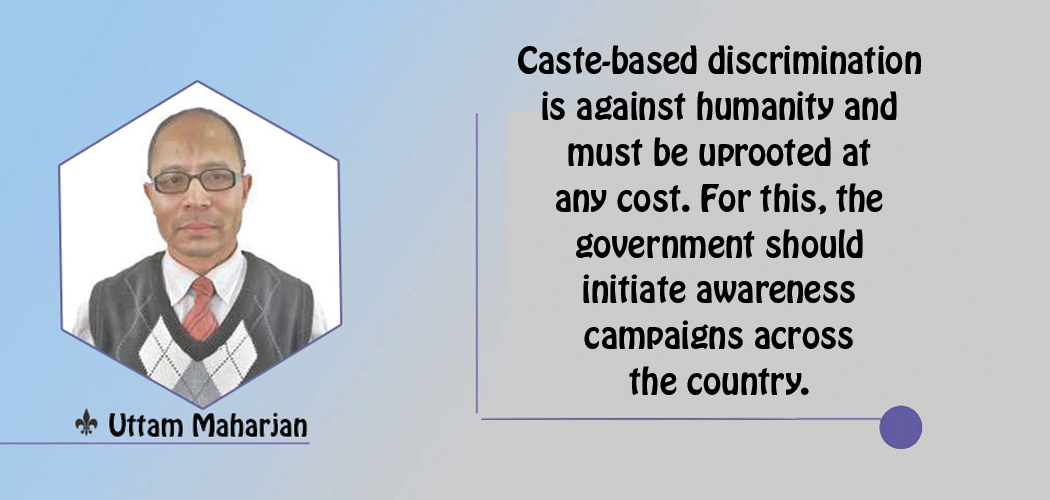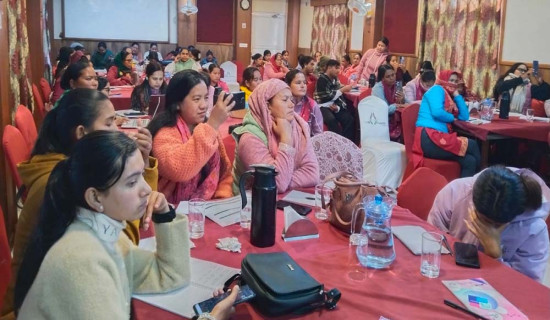- Wednesday, 24 December 2025
Dalits Still In Need Of Social Justice
Uttam Maharjan
Nepal is a multi-ethnic country with 125 ethnic groups. The caste system, which has persisted for centuries, is still prevalent in the country. The caste system is not bad per se but indulging in caste-based discrimination certainly is. Dalits are considered a lower caste. Over 20 Dalit castes exist in the country. They are discriminated against by higher-caste people on the basis of their very caste. They are not only humiliated at the hands of higher-caste people but also physically assaulted. They are subjected to assault and battery, physical and mental torture, rape, break-up of inter-caste marriages, false allegations, beatings in public places, etc.
Dalits are considered untouchables. They are not allowed to practise religious freedom. They are deprived of their right to perform religious rites. It is believed that if they perform religious rites or worship at temples, the rites or temples will be desecrated.
Poverty
In the past, Dalits were discriminated against on the basis of occupations. They were restricted to lower-level occupations such as blacksmith’s or goldsmith’s calling, tailoring, shoemaking or street cleaning. According to the Central Bureau of Statistics (2011), the rate of poverty among the Dalits is as high as 48 per cent. Dalits lack other means of living. The plight of Dalit women and children was even worse than that of Dalit men.
For lack of skills and because of low literacy, they did not get to work in factories and other businesses. The rate of literacy among Dalits as per the Central Bureau of Statistics (2011) is just 40 per cent. Dalits face discrimination in education. Dalit students are tut-tutted in schools. Not only fellow students but also teachers used to despise them. In some places, they were not even allowed to enter classrooms. So they used to be forced to suffer mistreatment for no fault of theirs. What is more, Dalits were discouraged from becoming teachers. Even if they became teachers, they would be denied higher positions.
They were also prohibited from entering temples, believing that they may defile the temples. They were forced to worship outside the temples. Likewise, they were prohibited from entering the houses of higher-caste people lest they should wreak havoc on the clannish ancestors. They were also barred from visiting hotels, restaurants, factories and other public places. There was also a conservative thinking that if Dalits entered a cowshed and touch the ropes of the cows and the water pots, the cows could give less milk. All these are based on social superstitions. Should they violate any rules unfairly imposed upon them, they were not only humiliated but also beaten up.
Although such atrocities are punishable by law, those who have to punish the guilty side with the perpetrators. Sometimes, such cases are settled locally. Dalits are often subjected to social ostracism. Inter-caste marriage of a Dalit to a non-Dalit often results in a social boycott. Sometimes, such Dalits are even tortured. Dalits are forced to follow traditional practices such as disposal of dead animals. Failure to do so may result in social ostracism. In politics, Dalits have lower representation. Higher echelons in politics are occupied by higher-caste people. Dalits are still a marginalised group as far as political positions are concerned.
However, rays of hope have emerged on the horizon after the formation of the federal structure. With this, the political participation of Dalits has encouragingly increased. There are 19 Dalit members in the House of Representatives, 33 members in the province assemblies and seven members in the National Assembly. At the local level, there are 797 male ward members, 6,567 female ward members, 197 ward chairs, one rural municipality chair, 16 rural municipality vice-chairs, six mayors and 11 deputy mayors. There is a good provision that a political party should field at least a female Dalit woman as a ward member. Because of this, Dalit women outnumber Dalit men in ward offices across the country.
As Dalits are an exploited group, the government should strongly enforce the laws to end such disceiminations. When Dalits are discriminated against, they cannot oppose such discrimination because the perpetrators are often higher-caste people who have pelf, power and connections with political leaders. Even law enforcers or political leaders side with the perpetrators. Such a trend must come to an end. Those who discriminate against Dalits, be it at temples, schools or any other place, should be subjected to legal action. Untouchability and other suchlike social malpractices should be eliminated for good. Those who resort to such malpractices should be brought to book without fail.
Awareness drive
Further, the government should embark upon socio-economic uplift and empowerment programmes for Dalits. The government, political parties, Dalit organisations and other stakeholders should act in synergy to make such programmes a success. It would be relevant to mention the eight-point programme launched in June 2001. The basic thrust of the programme was to eliminate untouchability, uplift and empower Dalit communities and enforce punishment for caste-based discrimination. But the programme petered out. However, such programmes need to be revived.
Caste-based discrimination is against humanity and must be uprooted at any cost. For this, the government should initiate awareness campaigns across the country. Even educated people are found discriminating against Dalits. Further, Dalit organisations should work in tandem with other organisations representing other marginalised groups such as women’s organisations and indigenous people’s organisations. Unity among such groups will contribute to improving the lot of marginalised communities, including Dalits, in the country.
(Maharjan has been regularly writing on contemporary issues for this daily since 2000. uttam.maharjan1964@gmail.com)

















